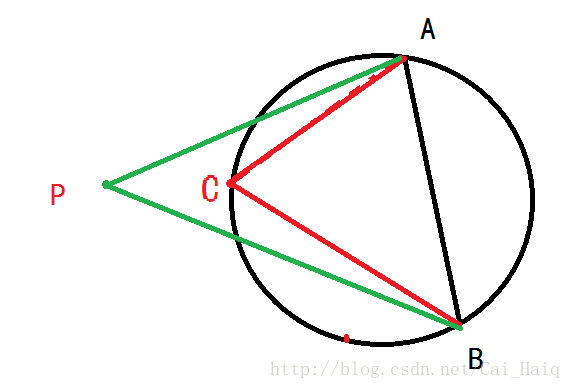HDU6206Apple(Java可以过,但是我有一个大胆的想法)
比赛的时候我有些蠢了。。。
本来想这是个签到题,一看69发,0A。接着就怂了。然后我有个大胆的想法,(接下来说大胆的想法)当时把我激动坏了,(真的蠢)没有这个大胆的想法一看有Java 过了的早就想到用大数A了。结果写了好久才发现人家大数A了,才去写Java。。。
这个题的坑在于数据范围超过了double的精度,所以会有精度丢失,用Java大数就怕了。BigDecimal的精度足够。
Java code:
import java.math.*;
import java.util.Scanner;
public class Main{
public static void main(String[] args) {
// TODO Auto-generated method stub
Scanner cin=new Scanner(System.in);
BigDecimal two=new BigDecimal("2.0");
BigDecimal x1,y1,x2,y2,x3,y3,x,y,X,Y;
int kase;
kase=cin.nextInt();
for(int i=0;i
{
x1=cin.nextBigDecimal();
y1=cin.nextBigDecimal();
x2=cin.nextBigDecimal();
y2=cin.nextBigDecimal();
x3=cin.nextBigDecimal();
y3=cin.nextBigDecimal();
X=cin.nextBigDecimal();
Y=cin.nextBigDecimal();
BigDecimal a, b, c, g, e, f,r2;
e=two.multiply(x2.subtract(x1));
f=two.multiply(y2.subtract(y1));
//g = x2*x2 - x1*x1 + y2*y2 - y1*y1;
g=x2.multiply(x2).subtract(x1.multiply(x1)).add(y2.multiply(y2)).subtract(y1.multiply(y1));
//a = 2 * (x3 - x2);
a=two.multiply(x3.subtract(x2));
//b = 2 * (y3 - y2);
b=two.multiply(y3.subtract(y2));
//c = x3*x3 - x2*x2 + y3*y3 - y2*y2;
c=x3.multiply(x3).subtract(x2.multiply(x2)).add(y3.multiply(y3)).subtract(y2.multiply(y2));
//X = (g*b - c*f) / (e*b - a*f);
x=g.multiply(b).subtract(c.multiply(f)).divide(e.multiply(b).subtract(a.multiply(f)));
//Y = (a*g - c*e) / (a*f - b*e);
y=a.multiply(g).subtract(c.multiply(e)).divide(a.multiply(f).subtract(b.multiply(e)));
//R = sqrt((X-x1)*(X-x1)+(Y-y1)*(Y-y1));
r2=x.subtract(x1).multiply(x.subtract(x1)).add(y.subtract(y1).multiply(y.subtract(y1)));
BigDecimal dis2;
dis2=X.subtract(x).multiply(X.subtract(x)).add(Y.subtract(y).multiply(Y.subtract(y)));
if(dis2.compareTo(r2)==1)
System.out.println("Accepted");
else
System.out.println("Rejected");
}
}
} 接下来说说害了了我好久的大胆的想法:
用long long 避免小数运算,这样精度就够了。
然而有点复杂,最后放弃了,如果有空了也许会补上AC代码,现在先把错的贴上

思路:
首先判断P是否在AB,BC,AC三条边上;
然后判断P和C是同侧还是异侧。

如果是同侧,那么如果∠APB比∠ACB小,那点P一定在圆外,否则在园内。
如果是异侧,∠APB+∠ACB要小于180度;
比较大小用到余弦定理。
#includereturn true;
else return false;
}
}
bool judge3(point a,point b,point c,point d)
{
ll dian1=diancheng(a,c);
ll dian2=diancheng(b,d);
if(dian1<0&&dian2<0)
return false;
else if(dian1>0&&dian2>0)
return true;
else{
if(dian1>0)
{
dian1=dian1*dian1/dis(a)/dis(c);
dian2=dian2*dian2/dis(b)/dis(d);
if(dian1>dian2)
return true;
else return false;
}
else{
dian1=dian1*dian1/dis(a)/dis(c);
dian2=dian2*dian2/dis(b)/dis(d);
if(dian1return true;
else return false;
}
}
}
bool judge(point a,point b,point c,point d)
{
if(eq(a,d)||eq(b,d)||eq(c,d))
return false;
point pp2=jian(a,d);
point pp0=jian(b,d);
if(pp2.x*pp0.y-pp2.y*pp0.x==0)
{
if(judge1(pp0,pp2))
return true;
else
return false;
}
ll x1=chacheng(pp2,pp0);
point pp3=jian(a,c);
point pp1=jian(b,c);
ll x2=chacheng(pp3,pp1);
if(x1*x2>0)
{
if(judge2(pp0,pp1,pp2,pp3))
{
return true;
}
else
return false;
}
else
{
if(judge3(pp0,pp1,pp2,pp3))
{
return true;
}
else
return false;
}
}
int main()
{
int kase;
scanf("%d",&kase);
while(kase--)
{
for(int i=0;i<4;i++)
{
cin>>p[i].x>>p[i].y;
}
if(judge(p[0],p[1],p[2],p[3]))
{
printf("Accepted\n");
}
else{
printf("Rejected\n");
}
}
}